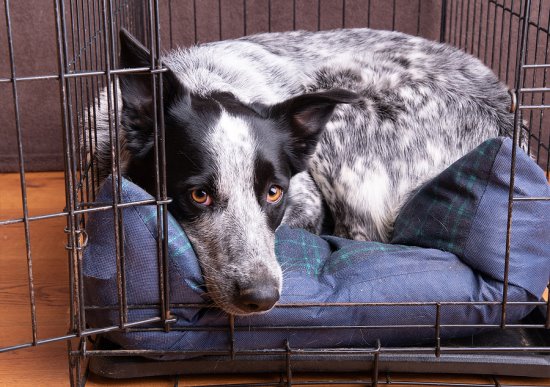| | Published September 29th, 2021
| Comfortable in a crate
| | | By Mona Miller, DVM |  | | bigstock images |
The recent California wildfires and Hurricane Ida have reminded me of an important aspect of pet disaster preparedness - crate comfort. Additionally, the ability to be comfortable and calm in a crate is useful for puppy housebreaking training, as well as pet confinement in instances when restricted activity is part of a treatment plan, such as a fractured leg.
 We commonly think of crate training as an important and necessary part of housebreaking behavior for puppies, since being in a small contained area will trigger inhibition of soiling in the "safe den." We also use crate training for puppies when we/they just need a break from the constant monitoring, to make sure the pup isn't chewing or destroying something in the household. In this way, we often assign a negative value to a dog being in a crate, as if it's a punishment or a time-out. However, for crate training to serve all the purposes that it can, it is important to understand that being in a small, confined space should have positive value - to be in an area to self-soothe (perhaps with a loaded food Kong), to rest from the stimulus of the household, to heal from a fractured bone or sore muscle, and to be safe and secure in the event that small containment is necessary for safety and survival, such as in a natural disaster.
We commonly think of crate training as an important and necessary part of housebreaking behavior for puppies, since being in a small contained area will trigger inhibition of soiling in the "safe den." We also use crate training for puppies when we/they just need a break from the constant monitoring, to make sure the pup isn't chewing or destroying something in the household. In this way, we often assign a negative value to a dog being in a crate, as if it's a punishment or a time-out. However, for crate training to serve all the purposes that it can, it is important to understand that being in a small, confined space should have positive value - to be in an area to self-soothe (perhaps with a loaded food Kong), to rest from the stimulus of the household, to heal from a fractured bone or sore muscle, and to be safe and secure in the event that small containment is necessary for safety and survival, such as in a natural disaster.
 A friend of mine recently posted a photo on Facebook of a store filled with medium and large crates, as well as small cat carriers, with well-behaved and calm pets inside their respective enclosures. In some crates, there were up to 5 dogs resting together quietly. This photo was taken during the August wildfires in Northern California and the post started with a benign but effective comment: "You never know when crate training comes in handy."
A friend of mine recently posted a photo on Facebook of a store filled with medium and large crates, as well as small cat carriers, with well-behaved and calm pets inside their respective enclosures. In some crates, there were up to 5 dogs resting together quietly. This photo was taken during the August wildfires in Northern California and the post started with a benign but effective comment: "You never know when crate training comes in handy."
 It went on (with some inflammatory language) to point out that emergency responders are sometimes put in the position of having to decide which pets to try to save, and the animals who are chosen are the ones who can be put in a crate. Dogs who are demonstratively aggressive in small spaces will not find themselves chosen. Conversely, dogs who are so frightened about being confined, but submissively willing, will find themselves housed for days, perhaps weeks, in a crate during a disaster - and while those lives have been saved, think of the anxiety and stress those dogs undergo.
It went on (with some inflammatory language) to point out that emergency responders are sometimes put in the position of having to decide which pets to try to save, and the animals who are chosen are the ones who can be put in a crate. Dogs who are demonstratively aggressive in small spaces will not find themselves chosen. Conversely, dogs who are so frightened about being confined, but submissively willing, will find themselves housed for days, perhaps weeks, in a crate during a disaster - and while those lives have been saved, think of the anxiety and stress those dogs undergo.
 As with most training, successful habituation to a crate occurs when the crate is paired with positive reinforcement. The crate should represent a safe, quiet and even fun place - where new toys are introduced and food/treats are provided. Sometimes habituation may take just a few tries - for instance, with a food-motivated breed such as a Labrador Retriever, a Kong with peanut butter put in the crate when you leave the house will readily encourage him to go into the crate first! However, other times, it may take gradual gentle steps - removing the top of the crate and feeding the dog nearby, working up to the top covering half the crate, and so on. The key is persistence, consistency and reward.
As with most training, successful habituation to a crate occurs when the crate is paired with positive reinforcement. The crate should represent a safe, quiet and even fun place - where new toys are introduced and food/treats are provided. Sometimes habituation may take just a few tries - for instance, with a food-motivated breed such as a Labrador Retriever, a Kong with peanut butter put in the crate when you leave the house will readily encourage him to go into the crate first! However, other times, it may take gradual gentle steps - removing the top of the crate and feeding the dog nearby, working up to the top covering half the crate, and so on. The key is persistence, consistency and reward.
 All of my comments above apply to cats as well. Often cats are put in carriers exactly once a year, for an annual wellness visit at the vet, or when they are not feeling well. Cats get very stressed being in crates if this is the only exposure. But most cats like to sit in boxes, so why don't we put the open crate out in the family room and let the cat explore and become comfortable? The top-loading crates are especially fun - it's no different than jumping in and out of a cardboard box.
All of my comments above apply to cats as well. Often cats are put in carriers exactly once a year, for an annual wellness visit at the vet, or when they are not feeling well. Cats get very stressed being in crates if this is the only exposure. But most cats like to sit in boxes, so why don't we put the open crate out in the family room and let the cat explore and become comfortable? The top-loading crates are especially fun - it's no different than jumping in and out of a cardboard box.
 Additional reading can be done here:
Additional reading can be done here:
 https://www.siriuspup.com/files/blueprints/07HomeAlone.pdf
https://www.siriuspup.com/files/blueprints/07HomeAlone.pdf
 https://veterinarypartner.vin.com/default.aspx?pid=19239&id=8569058
https://veterinarypartner.vin.com/default.aspx?pid=19239&id=8569058 |
| | | | | | | | | | | | |



